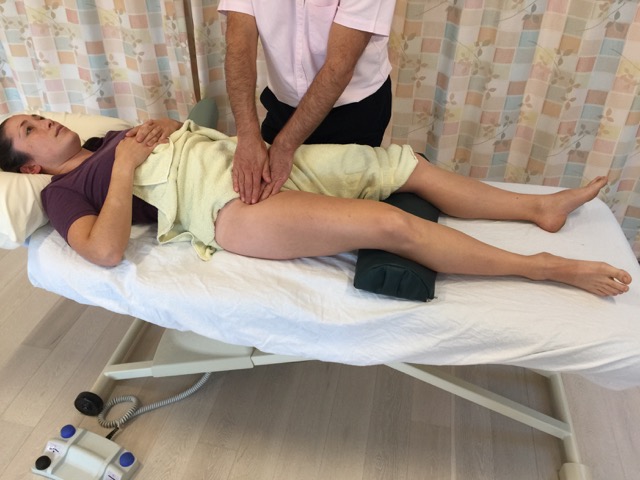Manual therapy treatment:

Soft tissue manipulation of the sartorius. Permission: Joseph E. Muscolino. Permission: Joseph E. Muscolino.
Manual therapy treatment for meralgia paresthetica is primarily oriented toward removing the physical stressors that are likely causing the condition. Advise the client/patient to wear clothing that is loose and comfortable and does not press against their hips. If the client is overweight, weight loss is important. Also advise the client to stop or lessen any offending postures such as standing in excessive posterior tilt, or activities, such as activities or sports that involve repetitive or excessive thigh extension.
If tightness is found in any of the hip flexors, then moist heat, followed by soft tissue manipulation (massage) and stretching may be helpful; particular attention should be paid to the sartorius and tensor fasciae latae (TFL). Because these two muscles are both hip flexors and hip abductors, they should be stretched both into extension and into adduction.
Ice might also be done to numb the area to reduce discomfort. Mobilization (arthrofascial stretching) of the hip joint might be beneficial at removing fascial restrictions in the region. And, some sources state that strengthening the anterior abdominal wall can be helpful toward relieving the symptoms of meralgia paresthetica.
Summary of Manual Therapy Treatment Protocol for Meralgia Paresthetica
| 1. Wear loose and comfortable clothing. |
| 2. Lose excess weight |
| 3. Avoid prolonged sitting; and avoid or lessen standing in excessive posterior tilt or activities that involve repetitive or excessive thigh extension. |
| 4. Moist heat, soft tissue manipulation, and stretching to the hip flexors |
| 5. Ice to numb the pain |
| 6. Mobilize (arthrofascially stretch) the hip joint. |
| 7. Strengthen the anterior abdominal wall. |
Precautions/contraindications:
If the client/patient has pain or hyperesthesia, then the therapist should exercise caution to not excessively increase their discomfort. Caution should also be observed to avoid any unnecessary pressure directly on the lateral femoral cutaneous nerve when performing soft tissue manipulation (massage). Also, care should be exercised when stretching the hip flexors to avoid excessive extension that might compress and irritate the nerve.


